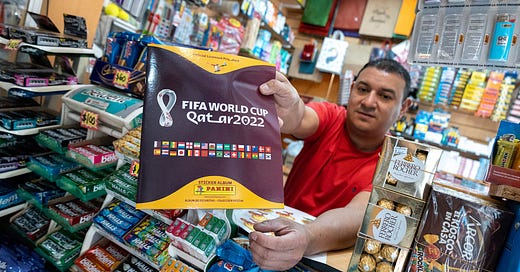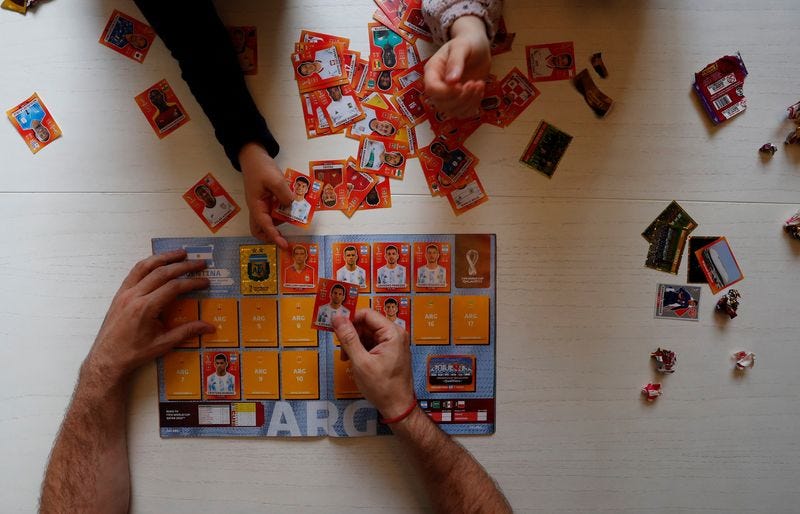Earlier this week, representatives of Argentina’s kioskos (small convenience stores) met with the Secretary of Commerce to discuss the country’s most talked about issue: a massive shortage of World Cup stickers and albums. Sticker collections have a long and storied history, and World Cup stickers particularly are a highlight - to the point where Argentina is usually expected to be the single biggest market for the stickers.
A World Cup sticker album usually looks like this:1 you buy the album, you buy packs of five stickers one at a time, you stick the ones you don’t have on the album, you buy more. A common passtime is to trade leftovers with your friends - with high demand stickers (such as, say, Messi) being more valuable than some African team’s goalkeeper. For illustration, the process looks like this:
Kioskeros have described the situation in dire terms, claiming that they only get 25 packets of stickers and five albums each - not a big amount. They are also claiming that bigger actors, such as supermarket chains, wholesalers, and online retailers, are getting the bulk of the action. While the official price is often 150 pesos (or 50 USD cents), some have started selling at 225 pesos (75 cents), the black market rate is quoted as 300 pesos (1 dollar), and the online marketplace Mercado Libre sells them at roughly 500 pesos each (1.66 dollars).
The reason I’m interested in this, besides the fact that not enough stickers has somehow turned into a national crisis, is that it seems to be a very simple issue of supply and demand: there are too few stickers and too many buyers. Demand is simply caused by the short time the stickers are on the market (basically just four months), and the interest in football overall. So what’s going on with supply?
Sticker madness
Demand is clearly high: in the first three weeks the album was available, 42% more albums and 18% more stickers were sold. Thus, it’s clear that the supply of stickers is constrained, and that the issue is literally not enough of them being available. The reason why is more interesting.
The first fact to name is that there seem to be hiccups in the supply chain (as with everything). The company didn’t expect to have such a high demand this year, and is struggling to increase supply in time, though they also mentioned this in August. An analogy made is with the Toddy chocolate chips cookies, which became a national sensation roughly a decade ago - and which, due to higher than expected demand, were scarcely available for months. The local distributor for the stickers is under a binding agreement with Panini (the company that owns the rights to the stickers) that prevents it from using any other printers, meaning that until capacity in their main plant is expanded, they’re not increasing supply.
The second issue is that there is a workaround for the sticker drama - importing the stickers. Technically they’d make them in another country (usually Brazil) and then sell them domestically - which they allegedly did for the 2018 World Cup, which itself broke the previous record (the 2014 World Cup) for sticker sales in the country. It’s not especially clear where the stickers are made, since even though they technically can only be made in the country, Mercosur (a bizarre trade bloc that mostly serves the purpose of protecting its members from trading with anyone else) rules don’t really place many restrictions on what exactly counts as “made in Argentina”. In data found by this (very good) newsletter, the manufacturer/distributor for the stickers is importing eight times more items than last year, with the vast majority of their stickers coming from Brazil and Italy (93%), and with almost the entirety of them corresponding to paper and cardboard goods - so either finished stickers themselves or the raw materials to manufacture them.
The problem with imported stickers is that, well, they’re imported, and that importing has become increasingly difficult in Argentina. The country has two exchange rates: the official rate, of 150 pesos per dollar, and the market rate, of 300. The official rate is extremely overvalued, having grown significantly less than inflation every month since mid 2019. A consequence of this is that exports become expensive and imports become cheap - and under a fixed rate, the difference comes from reserves. Given that the Central Bank made a deal with the IMF where they’d increase reserves by USD 5 billion this year, and so far they’ve lost several times that amount in July and August alone, they’re placing as many restrictions on imports as they can.
The specifics here are pretty simple. To import basically everything, you need to be cleared through the Integral Import Monitoring System (SIMI in Spanish), a customs system where the government decides who can import and how much. There’s two kinds of SIMI clearances: an immediate one, where you can pay for whatever you import instantly, but your company’s imports need to be 5% lower than in 2021; and a deferred one for everyone else, where you get your goods but can only pay for them in 180 days. Since very few foreign companies want to take the risk of selling something that will only be paid for in half a year, this is a de facto ban. Given that imports at the local distributor have surged in 2022, they’re definitely not getting the immediate SIMI clearance, and it’s probable that their distributors in Brazil and Italy aren’t going to be selling to them in these circumstances. Another point in favor of the import restrictions idea is that Ecuador, Uruguay, and Brazil, which are also undergoing stickermania, don’t have shortages of anywhere near the same magnitude - and don’t have the same extreme licensing requirements for imports.
Sticker prices
But wait a second - why are prices still at 150 pesos when there is at least 42% more demand for stickers and way fewer of them? They’re more expensive in the “parallel market”, or online, or even in the much dreaded alternative distribution channels. Why don’t the kioskeros simply charge more for the stickers they do actually have?
The technical case is pretty simple. The cost (to the kioskos) for a sticker package appears to be fixed at 120 pesos; under normal demand and supply, they’d be selling them at 150. But since demand is especially high, they could probably go significantly higher - at least twice that much, or maybe even up to four times the marginal cost. Some have done this - many in the kioskero community and the media have complained about excessive markups for stickers, and anecdotes abound about kioskos restricting sticker sales to buyers of other (expensive) goods, such as large chocolate bars. Morality aside, they have a scarce commodity that too many people want, so it’s in their best interest to charge as much as they want - and the customer’s only option is to pay up or shut up. But “morality aside” misses the point: customers may view the price gouging of stickers as repugnant2, which would make them less likely to engage in any business of any sort with the kiosko.
There’s a second layer of prices to consider: why is the price fixed at 120 pesos per package? From the media coverage, it would seem UKRA (the kiosko owners’ “union”) and the companies involved made a deal to keep prices fixed at 120 for the entire duration of the World Cup. Kiosko owners allege that the distributors shut them out and sell most of their stickers to other channels and, regardless of the veracity of the allegations, it would seem that’s a reasonable thing to do. If there is a much higher price available for a transaction, it’s not unreasonable to simply not sell to the lower bidder and prefer other channels of distribution as well.
Conclusion
All in all, there seems to be a simple story: the kioskos fixed a specific price for the stickers, supply and demand confabulated so that the market price was much higher, and are now complaining because the company is technically adhering to their deal while actually screwing them over. While there is an actual physical shortage of World Cup albums and stickers in the country, there is also a lack of World Cup stickers at the original price, simply because too many people want to pay it and too few people want to sell at it. Of course, the kiosko reaction was to demand the government intervene and grant them exclusive rights to stickers, which they might actually get because the country’s policymaking is a joke.
But this obviously mirrors another noteworthy commodity for the country: the US dollar. At a fixed price (the government’s exchange rate), everyone wants to buy and nobody wants to sell, while everyone wants to sell but not buy in the parallel markets. The government’s solution was to ban buying in the official market and not allow the majority of selling on the parallel market, which caused a large shortage of dollars reflected in an increasingly worsening international reserves position. The reaction of everyone involved was, unsurprisingly, to demand that their own finances be placed first - and so far most of the well connected enough actors and sectors have succeeded, while regular people scratch their head and wonder why the country is running out of their regular medications.
In the online era, there’s also a “virtual album” where you collect digital stickers, but it’s the lamest thing ever - and is also subject to an insane amount of exploits for free stickers due to very shoddy app design.
In this context, “repugnance” refers to a market transaction that is frowned upon by third parties due to “moral preferences” and not due to any direct harms - a “moral externality” of sorts. Simply put, someone doesn’t like the business that is being conducted - think of the opposition to organ markets or to bans on (voluntarily) purchasing horse meat to eat.





